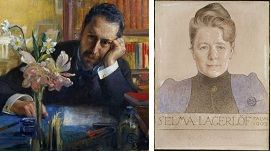
Press release -
Carl Larsson exhibition opens 13 June
Nationalmuseum will open its temporary exhibition venue at the Royal Swedish Academy of Fine Arts at Fredsgatan 12 in Stockholm with an exhibition entitled Carl Larsson – Friends and Enemies. Focusing on Carl Larsson’s networks and relationships, the exhibition reflects the Swedish art world in the period from 1870 to 1920. In all, about 120 works by Larsson and his contemporaries will be on show.
It is no exaggeration to say that Carl Larsson is Sweden’s best-known and best-loved artist. However, opinions on him are divided: Is the idyll fabricated? What were his views on women? Is he truly a good artist?
This exhibition will present the Swedish art world between 1870 and 1920 through the story of Carl Larsson, his associates and his relationships – from bohemian life in Stockholm, Paris and Grez-sur-Loing to Larsson’s increasing politicization against the backdrop of the First World War. The focus is mainly on fellow artists, teachers, collectors, critics and writers, but also on Larsson’s neighbours and employees at Sundborn and his own circle of family and friends, where he found the motifs for many of his most famous works. Known and unknown images of Larsson’s wife, Karin Bergöö, will be presented in a special section, as will an in-depth examination of Larsson’s close friendship with Anders Zorn.
Carl Larsson was a personal friend or acquaintance of most members of Sweden’s cultural elite. However, unlike most of them, he had first-hand experience of life on the lowest rungs of the social ladder. He painted portraits of Nobel laureates and infants, maidservants and princes with the same emotional investment. Some of his portraits of writers have become famous or even iconic – especially the frontal depictions of Selma Lagerlöf, Oscar Levertin and August Strindberg, which will be on display. The exhibition will also cover Larsson’s relationships with the patrons and art collectors of his day, such as Pontus Fürstenberg, Ernest Thiel and their families. Included in the exhibition is a new acquisition, purchased by Nationalmuseum in late 2012: a portrait of Thorsten Laurin, art collector and co-founder of the Friends of Nationalmuseum.
But the dividing line between friend and enemy is a fine one. Carl Larsson and August Strindberg had been friends since the early 1880s, when Larsson produced illustrations for Strindberg’s Swedish People. However, in his 1908 work, A New Blue Book, Strindberg wrote a full-scale character assassination of Carl and Karin Larsson under the heading “Fabricated Characters”. In his autobiography Larsson recalls scouring the streets of Stockholm looking for Strindberg, armed with a knife to exact revenge.
Over the years, Carl Larsson was awarded some of the most prestigious public art commissions in Swedish history, albeit sometimes after prolonged disputes, as with the stairwell murals at Nationalmuseum. The setbacks he encountered continued to haunt him. His bitter description of his dark childhood in his autobiography contrasts starkly with the light and joy that permeate so much of his art. Through self-portraits, photographs and other images, the exhibition will try to present a true picture of the man at the centre of the circle. How did other people see him, and how did he see himself?
The exhibition will occupy three galleries in Nationalmuseum’s temporary venue at the Royal Swedish Academy of Fine Arts. It will comprise about 120 artworks, including almost 100 by Carl Larsson. The other artists represented include Julia Beck, Hugo Birger, Oscar Björck, Eva Bonnier, Per Hasselberg, Ernst Josephson, Karl Nordström, Hanna Pauli, Georg Pauli and Anders Zorn.
To accompany the exhibition, a catalogue will be published in English, Swedish and German with commentaries by Larsson experts such as Görel Cavalli-Björkman, Per I. Gedin and Torsten Gunnarsson, and by Martin Olin, the exhibition curator.
The exhibition runs from 13 June to 3 November 2013.
Special thanks to the Ad Infinitum Foundation for its generous support of the exhibition.
Further information
Hanna Tottmar, press officer, hanna.tottmar@nationalmuseum.se, +46 8 5195 4390
Press images
www.nationalmuseum.se/pressroom
Captions
Carl Larsson, By the Cellar, 1917, Nationalmuseum; Carl Larsson, Oscar Levertin, 1906, Bonniers Porträttsamling/Nedre Manilla; Carl Larsson, Selma Lagerlöf, 1902, Nationalmuseum.
Nationalmuseum is Sweden’s premier museum of art and design. The collections comprise older paintings, sculpture, drawings and graphic art, and applied art and design up to the present day. The museum building is currently under renovation and scheduled to open again in 2017. In the meantime, the museum will continue its activities through collaborations, touring exhibitions and a temporary venue at the Royal Swedish Academy of Fine Arts, Fredsgatan 12, Stockholm. Nationalmuseum collaborates with Svenska Dagbladet, Fältman & Malmén and Grand Hôtel Stockholm. For more information visit www.nationalmuseum.se.
